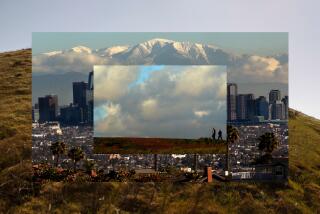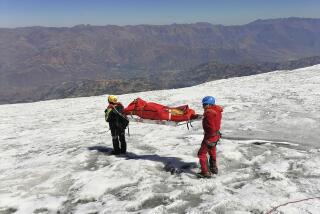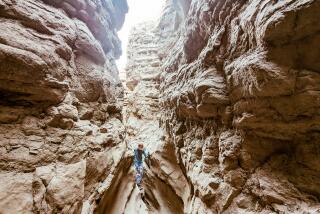Reaching new heights in the Andes
SORATA, BOLIVIA â The plan was simple: Drive up and walk down.
It made sense, after all, to use gravity to our advantage, especially because we were traveling in the oxygen-poor air three miles above sea level. But after 4 1/2 hours bouncing over kidney-bruising roads, shoehorned in the back seat of a Jeep with three others, our legs intertwined like spaghetti, I wondered if we had made a mistake.
I braced myself with one hand on the seat and one on the roof, trying, with each jackhammer-like jolt, not to land in my companionsâ laps.
The Jeep swayed heavily as we bounced through rocks and dirt. It was a challenge for my brother-in-law, Kevin Cadle, to keep his hands on the steering wheel. âWelcome,â he said, âto the 95% of roads in Bolivia that arenât paved.â
We had been climbing steadily on dirt roads since leaving La Paz, the capital, at 12,000 feet. Through dusty rear windows I could see the snowy peaks of the Cordillera Real range. The tallest stood more than a mile above our heads in a cloudless cobalt sky. We had timed our June 2001 visit to take advantage of the winterâs clear weather.
Kevin stopped to secure our backpacks, which were lashed to the roof rack. Happy for a chance to stretch my legs, I jumped out with Michael Fredette, a stocky 25-year-old from Massachusetts, and David Tayloe, 27, a clean-cut North Carolinian. Jaime Poyant, 26, Fredetteâs childhood friend, climbed out of the front seat. Kevin, 28, Michael and David had taught English throughout Latin America and Asia and were now stationed in Santa Cruz, an industrial city to the east of La Paz. They were on a break from a private school in eastern Bolivia. Jaime had flown to La Paz from the U.S. the day before, as I had.
I had come here to see what had drawn the teachers to Bolivia -- a country I never before dreamed of visiting. But a few days immersed in the countryâs culture and scenery convinced me that Kevin had discovered one of the few places on the globe largely untouched by the modern world.
My California home certainly seemed worlds removed from this pass at 15,000 feet, where we could look down on the resort town of Sorata. It hangs at 9,000 feet off the snow-draped massif of Mt. Illampu, more than 20,000 feet high. Its location makes Sorata an ideal base for mountain sports, hiking, climbing and backpacking, and we planned to stay there two days to adjust to the altitude before setting off on a three-day backpacking trip on the Choro Trail.
We climbed back into the Jeep, and when we crossed the RÃo San Cristóbal, it seemed we had stepped back in time.
Narrow cobblestone streets led to a central square, which was sun-drenched and empty at midday. Across from the church on the palm-lined plaza, we spotted the Residencial Sorata, a sprawling former colonial mansion with open verandas overlooking gardens, where we would stay before our trek. It is among the few lodgings in town. Airy hallways with wrought-iron railings hung over verdant gardens. I had to memorize the route between our two rooms, which required climbing stairs, crossing an atrium, winding along overgrown pathways and passing through several gates between the whitewashed buildings. The room I shared with Kevin and Michael had double glass doors that opened into a large room with mismatched furniture.
Leaving the hotel and the others behind to deal with a repair on the Jeep, I wandered the Plaza Enrique Penaranda. Aymara and Quechua Indians lined the sidewalks, sitting with their hands folded in front of displays of fruit, vegetables and wool clothes for sale. I bought some sweet finger-sized bananas, which I ate like candy.
Sorata gained prominence with rubber and gold, which the Incas carted off to Peru. In the colonial era, German families capitalized on the mines, many of which are still working. One German baron established the Casa Gunther in 1895, now the Residencial Sorata.
There were few shops to browse in, so I wandered the villageâs steep streets, climbing above the sea of red tile roofs for an exceptional view of the terraced hillsides that drop sharply to San Cristóbal. After the diesel-choked thoroughfares of La Paz, Sorata offered some much-needed tranquillity, and it was perfect preparation for our hike.
Echoes of Incan footsteps
We chose the Choro Trail, a one-way trek from La Cumbre to Coroico, because it was the easiest, though we had to backtrack south to La Paz to reach the trail head. Many other good trails, including the Lagunas Glacier and Chillata, Camino de Oro and Mapiri, begin in Sorata. Some are one-way journeys, as ours was. We hired a car to take us back to the trail head.
Our route would take us from the snowy reaches of the Andes to the jungle on the edge of the Amazon River basin. The transition is abrupt. On the 45-mile Choro Trail, we would descend 10,000 feet.
At a 15,900-foot pass, still free of snow, we donned our packs. âThis is as high as Iâve ever been,â David said. We stood higher than any point in the continental U.S., and still we could see much higher peaks.
A well-worn path sliced down the mountainside and into a deep canyon. As we walked down the trail, we stepped back to a time when the Incas ruled. The route was part of the network of highways that connected the Incan empire from Ecuador to northern Chile. As they had for centuries, Incas and their descendants, the Quechua, had crossed and recrossed this path.
The route through the grassy, arid plateau of the puna was well marked. We followed it for four hours into Achura, a small village that was only a few stone buildings surrounded by low-lying walls. Smoke from evening fires drifted in the thin air. The light had grown dim, obscured by the fog that had come up from the jungle. From here we would drop into the Yungas, a steamy cloud forest, wet year-round.
We stopped for the evening, carefully crossing a farmerâs field to camp beside the Phajchiri River. As we set up our tents, small figures appeared in the mist -- local children who stood like pillars, impervious to the cold. We had put on everything we had, jackets, pants and wool caps, and still we tried to warm our hands over the blue flame of the camp stove.
âOne night out here I can handle,â Kevin said, âbut I canât imagine a whole lifetime.â
The refrigerated air got us started early the next morning. As we trekked below Achura, the stonework of the Incan road appeared, tightly fitted and level, sweeping down the valley to green and lush steep slopes. We moved quickly over the path, which in places stretched to 15 feet, excessively wide for the light traffic we encountered early on a sunny morning.
The jungle soon overtook the stone trail, and then it nearly overtook us. Large ferns and banyan trees with roots that snaked in all directions made the going difficult. Twice, Kevin lost his footing above a ravine, but a quick grab at the hip-high brush stopped his fall. Making the trail even slicker was the rain that began to fall as soon as we dipped below the clouds. A light but constant stream coursed into my shirt and through the tops of my boots, and I sloshed with each step.
The path turned to dirt and the dirt to mud as we hiked under a canopy of trees that filtered out most of the daylight. In the shadows and underbrush, I spotted tight-fitting stonework structures that bore the characteristic Incan trapezoidal openings.
I puzzled at their purpose. Maybe they were storehouses to feed armies along the trail. Maybe they were cisterns for water. At that moment, I felt as if I were part archeologist, part explorer, part historian.
That evening, perched on a ledge high above an unnamed valley, we found a clearing big enough to pitch our three tents. The clouds brushed the tops of our heads, while the sunlight snagged the rocky peaks we had just passed. Far below we could hear the roar of the Huarinilla River, which drains the high Andes and eventually joins the Amazon.
From the trees came the screech of a flock of parrots. We found enough dead wood to start a good blaze. In the damp, still air, every snap of moisture from the burning branches reverberated around our little alcove.
We sat looking out across the valley. We could not see a single structure. We were connected to the rest of the world only by the thread of a muddy path, centuries old.
More to Read
Sign up for The Wild
Weâll help you find the best places to hike, bike and run, as well as the perfect silent spots for meditation and yoga.
You may occasionally receive promotional content from the Los Angeles Times.






